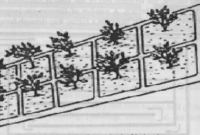The field is divided into smaller unit areas or beds measuring 10 to 100 sq metre or even more. Bunds or ridges are constructed around the areas forming basin within which irrigation water may be controlled. The basins are levelled in both directions. Small irrigation channels are provided between two adjacent rows of beds. Water is conveyed to the field by the stream of supply channel and lateral field channel. The supply channel is aligned in the upper side of the area and there is usually one lateral for every two rows of check basins Water from the lateral channel is turned in the beds and is cut oil when sufficient water has been admitted to the basin. The basins are filled to the desired depth and the water is retained until it infiltrates the soil.

This method is especially suitable for irrigating grain and fodder crops in heavy soil where water is absorbed very slowly.
Advantages/Benefits/Pros:
- It is more efficient method of irrigation arid ensures uniform application of water.
- It has good control on irrigation water and high water application efficiency.
- Though the Initial cost is high, it requires less labour and has low maintenance cost.
- Wastage of water and soil erosion is reduced as there is bund around the basin.
Disadvantages/Cons/Drawbacks:
- There are too many ridges which occupy the larger area of land. It involves the wastage of land.
- Lay out requirement in land preparation and irrigation is much bigger in check basin irrigation as compared to other methods.
- Repairing of ridges and careful supervision during irrigation is needed.
- Uneven distribution of water within the plot.
- The method impedes surface drainage, precise land grading and shaping are required.
